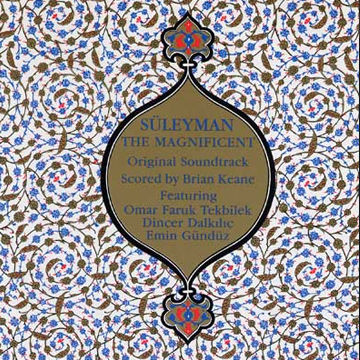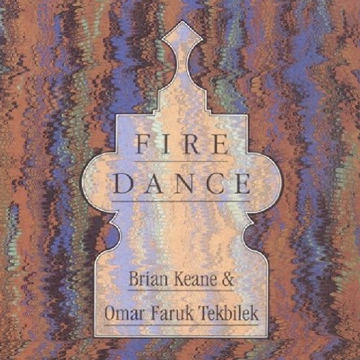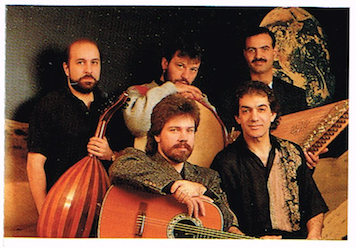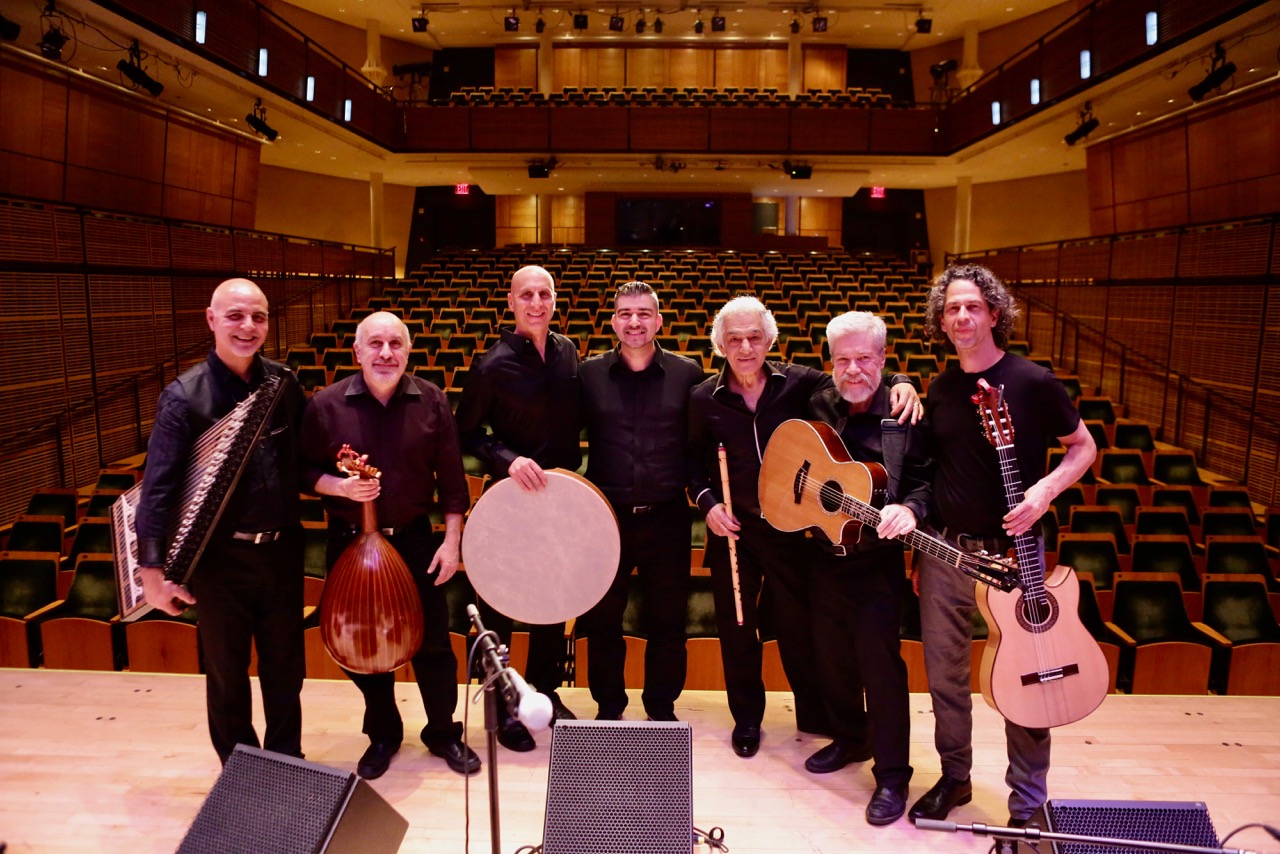
Middle Eastern Symphony
Brian Keane’s Middle Eastern Symphony came about as a result of an odd sequence of events, as did Brian’s whole connection to Middle Eastern music.
 In 1985, early in his documentary scoring career, Brian received a call from award-winning director Suzanne Bauman to score a film called “Suleyman the Magnificent.” Brian had scored an Oscar-nominated documentary for her earlier about Cuba, as well as a few other projects. Having no familiarity with Middle Eastern history or music at the time, Brian thought the film was a comedy at first. Brian would soon realize that the film was a documentary about the greatest ruler of the Ottoman Empire, and the project was a joint collaboration between The Metropolitan Museum of New York, The Art Institute of Chicago, The National Gallery in Washington, D.C., and PBS nationwide television, and would accompany a touring exhibit of Ottoman art in the United States. In 1985, early in his documentary scoring career, Brian received a call from award-winning director Suzanne Bauman to score a film called “Suleyman the Magnificent.” Brian had scored an Oscar-nominated documentary for her earlier about Cuba, as well as a few other projects. Having no familiarity with Middle Eastern history or music at the time, Brian thought the film was a comedy at first. Brian would soon realize that the film was a documentary about the greatest ruler of the Ottoman Empire, and the project was a joint collaboration between The Metropolitan Museum of New York, The Art Institute of Chicago, The National Gallery in Washington, D.C., and PBS nationwide television, and would accompany a touring exhibit of Ottoman art in the United States.
Realizing that he had taken on something that he knew virtually nothing about, Brian contacted famed music producer Arif Mardin, for whom he had worked briefly as a session guitarist (and who had come to the US from Turkey, becoming a very successful record producer with Atlantic Records, producing the Bee Gees, Aretha Franklin, and Bette Midler, among others). At first, Arif wasn’t aware of any accomplished Middle Eastern musicians living in the area either, but later called back to say that his cooks went to a belly dancing club in the west side of Manhattan called Fazil’s, and recommended that Brian check that out. Brian sent an assistant at the time, a former guitar student named Jay Gogan, to Fazil’s to look for Middle Eastern talent. After several visits, Jay came back with a vinyl demo record called “Faruk and the Sultans.” Brian was impressed with Faruk’s musicianship and went to see him perform.
 At the time, Omar Faruk Tekbilek hardly spoke any English, and Brian didn’t speak any Turkish or Arabic either. Omar had come to the US through his married family after being an Istanbul session musician and a student in Sufism. At that time, Omar was working at a raincoat factory in Rochester, New York during the week, and playing weddings and belly dancing clubs on the weekends, often driving several hours to New York and elsewhere to play music. At the time, Omar Faruk Tekbilek hardly spoke any English, and Brian didn’t speak any Turkish or Arabic either. Omar had come to the US through his married family after being an Istanbul session musician and a student in Sufism. At that time, Omar was working at a raincoat factory in Rochester, New York during the week, and playing weddings and belly dancing clubs on the weekends, often driving several hours to New York and elsewhere to play music.
Somehow, Brian and Omar managed to communicate enough to collaborate. Omar introduced Brian to other talented Middle Eastern musicians living in the New York area, some of whom were more Americanized at the time. Brian was able to learn about Middle Eastern music from Omar, and from the others. He would go on to write a score that combined traditional Middle Eastern music, original music written in a Middle Eastern style, and western film score orchestrating elements.
The first recording session for the “Suleyman" score took place at Carriage House studios in Stamford, CT in 1986. There was a projected image to watch, and Omar improvised on ney (a Middle Eastern flute) with Brian on synthesizer. The result was instant magic that people who were there say made the hair on the back of their neck stand up. The very first take ended up being the opening to the movie “Suleyman the Magnificent” and the beginning of a long, influential and significant relationship that would have a major impact on Middle Eastern music.
 Brian’s landmark score to the 1987 documentary “Suleyman the Magnificent” aired to critical acclaim on national television. Arif Mardin came to the premiere at The Metropolitan Museum in New York, and was brought to tears. Later, the score got picked up as a soundtrack CD by German record label Celestial Harmonies, after its president, Eckart Rahn, had seen the movie on television. Brian’s landmark score to the 1987 documentary “Suleyman the Magnificent” aired to critical acclaim on national television. Arif Mardin came to the premiere at The Metropolitan Museum in New York, and was brought to tears. Later, the score got picked up as a soundtrack CD by German record label Celestial Harmonies, after its president, Eckart Rahn, had seen the movie on television.
 Following the success of “Suleyman the Magnificent,” Celestial Harmonies convinced Brian to do a duo record with Omar Faruk Tekbilek as a follow-up release, and the resulting album “Fire Dance” was released in 1990. “Fire Dance” continued to build on the success of “Suleyman” in pioneering the connection of western musical elements to the musical traditions of the Middle East (which hadn’t existed before “Suleyman"). However, because Omar was still working a full time job in the rain coat factory in Rochester New York, the record took a long time to make. Following the success of “Suleyman the Magnificent,” Celestial Harmonies convinced Brian to do a duo record with Omar Faruk Tekbilek as a follow-up release, and the resulting album “Fire Dance” was released in 1990. “Fire Dance” continued to build on the success of “Suleyman” in pioneering the connection of western musical elements to the musical traditions of the Middle East (which hadn’t existed before “Suleyman"). However, because Omar was still working a full time job in the rain coat factory in Rochester New York, the record took a long time to make.
 On the next follow-up release, the 1992 “Beyond the Sky,” which Brian had to be talked into (as he had now become very much in demand as a record producer, composer, and had recently signed with Blue Note Records as a jazz artist), Brian and Omar decided to bring on some the most accomplished Middle Eastern musicians in the world to join them and make the record faster. Ara Dinkjian on oud, percussionist Arto Tuncboyaciyan, and a young and extremely talented kanun (Middle Eastern lap harp) and violin player named Hasan Isakkut became the core group along with Brian and Omar, and much of the record was recorded live as an ensemble. On the next follow-up release, the 1992 “Beyond the Sky,” which Brian had to be talked into (as he had now become very much in demand as a record producer, composer, and had recently signed with Blue Note Records as a jazz artist), Brian and Omar decided to bring on some the most accomplished Middle Eastern musicians in the world to join them and make the record faster. Ara Dinkjian on oud, percussionist Arto Tuncboyaciyan, and a young and extremely talented kanun (Middle Eastern lap harp) and violin player named Hasan Isakkut became the core group along with Brian and Omar, and much of the record was recorded live as an ensemble.
“Beyond the Sky” was created with huge critical and popular success. It was Echoes’ record of the year, and became iconic in the Middle East.
 However, at this point, there was a problem. Brian didn’t want to continue as a Middle Eastern artist; it wasn’t his heritage, and as he was also signed to Blue Note Records, as well as too much in demand as a record producer and composer, Brian didn’t want to do any more traditional Middle Eastern records as an artist. The record company was very reluctant to let such a successful entity go. In order to get the record company to change their mind, Brian told them that “if they wanted a Brian Keane record, then they would get a Brian Keane record,” and he wrote this Middle Eastern Symphony, and produced it with Omar, Ara, Arto, and Hasan as a way of making a statement to the record company that Brian was only interested in continuing on a strictly uninhibited artistic basis. However, at this point, there was a problem. Brian didn’t want to continue as a Middle Eastern artist; it wasn’t his heritage, and as he was also signed to Blue Note Records, as well as too much in demand as a record producer and composer, Brian didn’t want to do any more traditional Middle Eastern records as an artist. The record company was very reluctant to let such a successful entity go. In order to get the record company to change their mind, Brian told them that “if they wanted a Brian Keane record, then they would get a Brian Keane record,” and he wrote this Middle Eastern Symphony, and produced it with Omar, Ara, Arto, and Hasan as a way of making a statement to the record company that Brian was only interested in continuing on a strictly uninhibited artistic basis.
The symphony was never completed, and never released. This recording is all that remains. Eventually, Celestial Harmonies relented and accepted a deal in which Brian agreed to continue to produce the recordings that the record company wanted (similar to the formula that had become so popular with “Beyond the Sky,” but Omar would become the sole artist of record. Brian arranged for Omar to get enough of an advance that he could afford to quit his rain coat factory job, and become a full time touring musician, and Brian produced Omar’s first solo CD “Whirling.” Omar would go on to become a world renown Middle Eastern musician, touring the world, and recording many more projects with Brian throughout the years. While Brian quit his career as an artist to become one of the leading record producers of the 1990s and continue as the foremost composer in documentary films, Brian joined Omar in April 2018 for a reunion concert arranged by Carnegie Hall in New York. They had changed Middle Eastern music together, and the show sold out. In 2019, they will give some concerts together in the Middle East once again.
 Brian Keane’s Middle Eastern Symphony starts out mysteriously and atmospherically stating a mystical Middle Eastern inspired melody. After the melody is stated on the guitar, then the ney, a 5/8 figure comes in on synthesizers and electric piano with the melody restated on oboe and then ney. This hands to a fiery rhythmic theme with the ensemble of oud, kanun, and percussion, transitioning to a more rhythmically variant section blending synthesizers, orchestral woodwinds (played on synths at the time instead of live woods as the project was never finished), strings, Middle Eastern instruments and percussion in an orchestral development section. This section transitions back to the melody played mystically on ney over a return of the 5/8 figure. Brian Keane’s Middle Eastern Symphony starts out mysteriously and atmospherically stating a mystical Middle Eastern inspired melody. After the melody is stated on the guitar, then the ney, a 5/8 figure comes in on synthesizers and electric piano with the melody restated on oboe and then ney. This hands to a fiery rhythmic theme with the ensemble of oud, kanun, and percussion, transitioning to a more rhythmically variant section blending synthesizers, orchestral woodwinds (played on synths at the time instead of live woods as the project was never finished), strings, Middle Eastern instruments and percussion in an orchestral development section. This section transitions back to the melody played mystically on ney over a return of the 5/8 figure.
The middle section is a string adagio in 6/8 time with the occasional woodwind and ney. It is dissonant at times, sweeping, passionate, and stunningly beautiful. This section culminates in a beautiful ney melody with strings and ending with a 6/8 Ara Dinkjian oud solo and Arto’s percussion as a duet.
The final section transitions with truncated 5/8 phrases filled by Arto’s skillful percussion, and returns to the original melody over the 5/8 in a more orchestrated section, handing to an amazing guitar solo which shows off how accomplished Brian was at the time as a guitarist. That solo is followed by a fiery kanun solo by Hasan Isakkut with the rhythmic theme coming in underneath played by the ensemble, building with other instruments and coming to a flashy finish. The piece is almost 20 minutes in total length.
|
